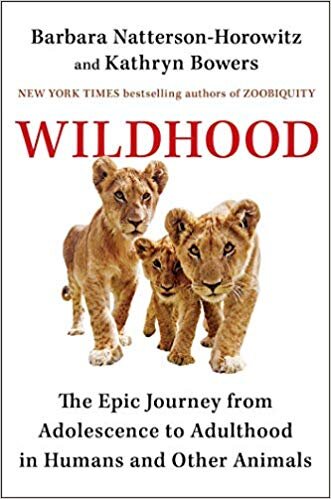Wildhood by Barbara Natterson-Horowitz & Kathryn Bowers
/Wildhood: The Epic Journey from Adolescence to Adulthood in Humans and Other Animals
By Barbara Natterson-Horowitz & Kathryn Bowers
Scribner, 2019
When presented with any book on the youth of non-human animals, there’s a certain contingent of readers, certainly all fishermen and surfers and sea-going folk, who will immediately hear “adolescent animal” and think of one thing: sharks. These people know better than most how dangerous adolescent sharks can be to humans. An adolescent great white shark, branching out into new hunting territories but still inexperienced in what it should be eating, is far more likely than an older shark to take a bite of something as strange-looking as a human.
And sure enough, the first thing mentioned in Wildhood is indeed adolescent sharks, although the book’s scope quickly expands to include most of the animal kingdom. Kathryn Bowers, a science journalist, and Natterson-Horowitz, a professor of medicine in the UCLA Division of Cardiology, have collaborated on a genuinely thought-provoking broad-range inquiry into the strange, elastic period between youth and adulthood, when crucial mistakes are made and crucial learning happens. Mature animals usually want nothing to do with humans; as our authors note, it’s animals in a state of “wildhood” who tend to blunder into contact:
When you hear a news report about a wild animal wandering into a mall, apartment lobby, or playground, you can be fairly certain that one of the next sentences will contain the phrase “adolescent male,” or “dispersing adolescent,” or sometimes “animal teenager.” More often than not, wild animals that go astray and encounter humans are in their wildhoods, making them desperate, low in status, hungry, territory-less, and biologically impelled to roam. Dispersing adolescents can find themselves in trouble when their inexperience meets the real world.
One of the many joys of Wildhood is its biological ecumenism; time and again the authors tacitly remind their readers that personal individuality - for two millennia guarded as a strictly human quality - is actually rife throughout the animal world:
Visualize a flock of starlings - the swirling clouds of birds that gather at sunset in massive formations containing thousands. To our eyes, they may seem as indistinguishable as peanuts in a bag. But every member of that flock is an individual, different from every other bird. Some are male; some are female. Some have been mature adults for several years; some are experiencing their first year in the flock with the big body of an adolescent but the inexperience of one too. Just as people come in different sizes, starlings can be stocky or wiry, tall or short, stiff or loose-jointed, calm or high-strung.
Wildhood is a thoroughly engaging study of the in-between years and the strands of commonality that run through the awkward adolescences of so many species. The book will teach you things about the torments and ecstasies you endured during your own in-between years, and it may incline you to look more kindly on the desperate, low-status blunderings of the teenagers who occasionally show up in your own home and on your own tax forms.
—Steve Donoghue is a founding editor of Open Letters Monthly. His book criticism has appeared in The Boston Globe, The Wall Street Journal, The Historical Novel Society, and The American Conservative. He writes regularly for The National, The Washington Post, The Vineyard Gazette, and The Christian Science Monitor. His website is http://www.stevedonoghue.com.
